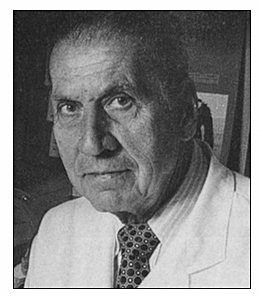
- Articles
On Psychosurgery and Mind Control — A Review of Violence, Mental Illness and the Brain by Russell L. Blaylock, MD
In his three-part series on psychosurgery in America, Dr. Miguel Faria has written one of the best summaries in print on the history of neurosurgical treatment of psychiatric disorders by selective sectioning or abolition of specific parts of the behavioral. Within these pages he discusses the anatomy involved and the interrelated nature of brain nuclei in altering human behavior in such a way as to bring clarity to a very difficult topic.
As a historian, Dr. Faria understands the social forces faced by these men when dealing with a very sensitive subject, bringing this point into very sharp focus in Part 3 of the series. Today, psychosurgery is mostly a thing of the past. Much of the pressure to end psychosurgery came from the American Left, but also came from the fact that better, less invasive methods became available.
At this point, I feel compelled to relate a story told by a visitor traveling with a group of leftist Americans to Communist Cuba, which is related in a collection of experiences in the book Destructive Generation by Peter Collier and David Horowitz. The group was taken to a psychiatric hospital to see some of the patients who had undergone a state-sponsored frontal lobotomy. The author of the piece said he turned to the person next to him, expressing horror, and asked, “But isn’t this what we are fighting against in the United States?” The person, nonchalantly turned to him and said, “You don’t understand, those are capitalist lobotomies—they are an abomination. These are socialist lobotomies.”
Like Dr. Faria, I also have a deep interest in behavior and brain function and studied the period of psychosurgery covered in his essays, having read many of the same books referenced in his papers. I first read Vernon Mark and Frank Ervin’s book, Violence and the Brain, soon after I went into private practice and I found it to be fascinating. One of the main themes in the book was the dyscontrol syndrome, which I still adhere to today.
What Mark and Ervin demonstrated was that a person with an otherwise perfectly normal anatomical brain can have a subcortical seizure within limbic and paralimbic structures of the brain and demonstrate episodic rage and even directed violence, the latter being more dangerous. It has only been with the advent of modern functional brain imaging that we have been able to come closer to proving that directed, i.e., planned violence, can also have an anatomic-physiological explanation. With the dyscontrol syndrome the impulse for violence becomes either disconnected from inhibitory systems, such as the orbitofrontal cortex and medial prefrontal cortex, or a seizure focus, usually in the amygdala, driving the impulse.
Mark and Ervin also found a strong link to alcohol exposure, ironically, with even very small doses, and point out that it does not appear to be the alcohol itself but rather some other link that is responsible for the phenomenon. They base this on the finding that IV alcohol in these individuals does not have the same effect. It could be the smell of the alcohol acting on olfactory pathways, which directly enter the limbic circuits.
What these two neurosurgeons demonstrated was critically important and still not fully appreciated by modern neurosurgeons and neurologists, much less psychiatrists. They further demonstrated that these seizures could not only involve discrete anatomical locations within the limbic system but also could remain silent both clinically and when using surface EEG techniques. In fact, many of these seizures can only be detected by depth electrodes or the more sensitive magnetoencephalography (MEG) testing. As a result, at least some violent individuals inhabiting our society are suffering from these behaviorally linked, silent seizures and therefore go undiagnosed.

Dr. Jose Delgado and Mind Control
Another scientist Dr. Faria discusses in his paper is the notorious Dr. Jose Delgado, a brilliant neurophysiologist and expert in behavioral control of the mind by depth electrodes. I say notorious because during the latter part of his career he went underground, no longer published his work, and was paid by the federal government to conduct studies on mind control. In a rare interview, he told a science reporter that he was now able to control some human behavior at a distance without having to use depth electrodes.
I was also fascinated, and frightened, by his book—Physical Control of the Mind: Toward a Psychocivilized Society. A great deal of the book is concerned with his physiological studies, many on primates. Of particular interest in human aggressiveness are his studies on planned aggression as opposed to mere sham rage attacks, which are more reflexic. Planned aggression during brain stimulation does not completely override behavioral control mechanisms, especially protective behavioral mechanisms, but rather heightens aggressive impulses and desires, making them more difficult to resist.

For example, Delgado found that stimulation of the lateral hypothalamus causes the animal to prowl around its cage looking for fights with subordinate animals, but still avoiding the most powerful of the group. This means that careful evaluation was being carried out based on previous experience and learned skills. Such behavior resembles the criminal who carefully plans his crimes, based on risk of being caught and the possibility that the intended victim might overcome him. Delgado also found that stimulation of specific points in the thalamus increased aggressiveness and caused “well directed attacks against other members of the group.”
In the latter chapters of his book, Dr. Delgado discusses the ethical and social aspects of brain control. He states:
New neurological technology, however, has a refined efficiency. The individual is defenseless against direct manipulation of the brain because he is deprived of his most intimate mechanism of biological reactivity. In experiments, electrical stimulation of appropriate intensity always prevailed over free will… Destruction of the frontal lobes produced changes in affectiveness, which are beyond any personal control.
Delgado then identifies the worst scenario:
The possibility of scientific annihilation of personal identity, or even worse, its purposeful control, has sometimes been considered a future threat more awful than atomic holocaust.
Further, Delgado justifies such intervention by noting that many public health interventions are done against the will of those involved for the “greater good”—a term often used by collectivists. (Of course, they are the ones who determine what constitutes the “greater good.”) Delgado concludes by defining the tremendous benefits to be gained from neurological alternation of human beings:
Its practical application…a means of escaping from the blind forces of chance and of influencing cerebral mechanisms and mental structure in order to create a future man with greater personal freedom and originality, a member of a psychocivilized society, happier, less destructive, and better balanced than present man.
The entire philosophy of socialism is predicated on the idea of perfecting man, thus creating a collective man, who is little more than a cog in the all-embracing wheel of the state. Delgado states, “The concept of individuals as self-sufficient and independent entities is based on false premises.” Like Feurbach and Comte before him, Delgado sees the uniqueness of man as a creation of God as disproven by Darwin and his cohorts. Having accepted the nonsense of evolution, Delgado sees no problem with recreating man in the elites’ image.
Today, a group of neuroscientists are working tirelessly to prove that free will is an illusion and that we are nothing more than cleaver animals. Using sophisticated functional brain imaging techniques, these nefarious haters of God are attempting to localize in the brain the attributes that make man unique—such as empathy, compassion, political beliefs, morality, musical ability and religious belief. Recent reviews have shown that many of these techniques have serious shortcomings and that often the proponents of functional imaging make giant leaps in interpretation not supported by the observations.
Dr. Delgado points out the major dilemma facing the brain engineers of today, “As our power to influence the mental structure of man continually increases, we face the question of the kind of people we would like to create.” Of course, as previously stated, it will be the Power Elite, who will decide.
Like others before him, Delgado states that we cannot wait for “evolution” to perfect the human brain; man must take the responsibility and speed up the process. This, of course, is the gnostic doctrine that states that all of us can become like gods with the intervention of the illuminated elites. Virtually all modern “isms” are driven by this premise.

The Role of Nutrition and Neurotransmission
Since the heyday of psychosurgery we have learned a great deal more about the workings of the human brain, and of most importance is the default brain—the silent thinking and analysis network. Pharmaceutical treatments have improved in some ways but in others appear to have made the problem worse, as seen with the triggering of homicide and suicides with SSRI medications.
Still not fully appreciated has been the tremendous role played by nutrition in brain function, both negative and positive. The studies by Barbara Reed Stitt (Food and Behavior: A Natural Connection) demonstrate a very powerful link between poor diets and criminal behavior, especially violent behavior and drug addiction. Newer revelations linking schizophrenia with intolerance to gluten and gliadin have changed the way we should think about this debilitating disorder and the link between glutamate metabolism and a growing number of neuropsychiatric disorders should likewise alter our thinking about serious psychiatric disease. In my DVD—Nutrition & Behavior (www.blaylockwellnesscenter.com)—I discuss other links between diet and behavior.
A number of newer studies have shown that the glutamatergic neurotransmitter system, which regulates most of the other neurotransmitters, is in turn altered by chronic inflammatory conditions, leading to behavioral abnormalities. I have called this linkage immunoexcitotoxicity. While neurosurgical procedures of a much more localized and specific type may offer further improvements in serious psychiatric disorders, we must carefully evaluate the moral dimensions of such interventions. In addition, we must guard against state intervention and control of such procedures.
Conclusion
Dr. Faria’s three-part series provides us with a very valuable overview of physical manipulation of the brain. I knew one of the personalities in Part 2, Dr. Orlando Andy, a very brilliant neurosurgeon at the University of Mississippi Medical Center. He pioneered a number of techniques for depth electrode studies and defined a number of functional responses that remain controversial. While recognizing his brilliance, he was often the subject of criticism based on his judgment in performing these studies.
If one reviews the studies done on patients undergoing the various psychosurgical procedures, such as frontal lobotomy, orbital undercutting, selective destruction of cingulate pathways and amydalectomy, one comes away with several realizations. Control of the worst of the patients—mainly for violent dyscontrol, schizophrenia and obsessive-compulsive behavior — by pharmaceutical and psychiatric techniques most often failed. Most such patients were relegated to a life confined in a mental institute. It was these individuals who were selected for psychosurgical treatments, being that all other methods had failed to help them.
Several contributors to Edward Hitchcock, et al’s book—Psychosurgery (Charles C. Thomas, Springfield, 1972) carefully evaluate the success rate of the various procedures. Several such studies reported as high as 80% of patients being able to return to work, with minimal interference with higher brain functions. Of course, one must appreciate that testing was less well defined and specific in that period.
Dr. William Beecher Scoville reviewed the effect of surgical lesions on the psyche and behavior in his patients in Arthur Winter’s book, The Surgical Control of Behavior (Charles C. Thomas, Springfield, 1971) and reported good results for a number of intractable behavioral problems, such as severe homicidal schizophrenia, drug addiction, and recurrent depression. He does note that psychopaths, sex perverts, and criminals rarely respond positively to lobotomy and many become worse.
Dr. Faria’s three-part series deserves high praise and are the type of articles that should be saved and re-read often. It is written in his usual clear style, well-organized and filled with interesting facts and anatomy.
Written by Russell L. Blaylock, MD
Dr. Russell L. Blaylock is President of Advanced Nutritional Concepts and Theoretical Neurosciences in Jackson, Mississippi. He has written numerous path-blazing scientific papers and many books, including Excitotoxins: The Taste That Kills (1994), Bioterrorism: How You Can Survive (2001), Health and Nutrition Secrets (2002), and Natural Strategies for Cancer Patients (2003). He is Associate Editor-in-Chief and a Consulting Editor in Basic Neuroscience for Surgical Neurology International (SNI).
This article may be cited as: Blaylock RL. On Psychosurgery and Mind Control — A Review of Violence, Mental Illness and the Brain. HaciendaPublishing.com, August 7, 2021. Available from: https://haciendapublishing.com/on-psychosurgery-and-mind-control–a-review-of-violence-mental-illness-and-the-brain-by-russell-l-blaylock-md/.
Copyright ©2021 Hacienda Publishing, Inc.
3 thoughts on “On Psychosurgery and Mind Control — A Review of Violence, Mental Illness and the Brain by Russell L. Blaylock, MD”
Dr. Blaylock touches on some very interesting subject matter here. Ironically, he brings up Dr. Delgado, who I immediately associate with the 1965 NY Times write-up of his famous bull experiments. Although he was proud to be a Spaniard and therefore educated in bullfighting, he did not make use of those skills. He had implanted electrodes in a bull’s limbic system, and wired them up so that they would deliver a dose of current when he pressed a button on a radio transmitter he held in his hand. He jumped in the bullring, and as the animal charged and came close to goring him, he pressed the button, immediately freezing the bull in its tracks. The bull did because the stimulation caused it to lose all aggression instantly. I say this is ironic because on Dr. Faria’s Facebook timeline we were recently discussing Ernest Hemingway, and we agreed one of his only works that does not bore us is his compilation of short stories, one of which at least is based on his bullfighting experience in early 1920’s Pamplona. Hemingway was anti-Franco, true, but it seems he went too far in the other direction, as was the original point of Dr. Faria’s thread. It’s funny that Delgado was anti-Franco too, but for some strange reason was tarred as fascist.
As concerns magneto-encephalography, I do not believe it can do much better differentiating the contribution of subcortical neurons to surface potential than the standard EEG [with nasopharyngeal leads], but it is superior in resolution to standard EEG if one wishes to determine where on the brain surface the potential measured is originating from.
I certainly appreciate the fact that only olfaction bypasses the thalamus and goes straight to the limbic system. I am guessing it does this because as the first sense to develop in animals, it may have preceded development of the thalamus OR because the first brains to possess it relied so heavily on scent for important information that there could be no delay in action by thalamic preprocessing. In humans, I don’t doubt this is why familiar aromas are capable of powerfully recalling distant memories. However, while I know that cases of “pathological alcoholic intoxication” usually have normal EEGs and are probably variants of deep seated mesial temporal lobe epilepsy, I just can’t see how the smell of alcohol could be the activating factor, given that those few molecules of alcohol which enter the nasal cavity to elicit the odor are never even going to pass the cribriform plate! I will have to read the publication claiming IV alcohol does not elicit these behaviors.
Adam
This 3-part series has been revised and amplified and incorporated into the first three chapters of my new book, Controversies in Medicine and Neuroscience: Through the Prism of History, Neurobiology, and Bioethics (May, 2023). https://www.amazon.com/Controversies-Medicine-Neuroscience-Miguel-Faria/dp/1527594173/
We still do psychosurgery, but now we have abandoned the destructive forms for deep brain stimulation. THAT is capitalist “lobotomy”, and only an ignorant Marxist symping idiot couldn’t see the difference. I am well aware of what kind of horror Cuba offers for medical care, yet a sizable number of American leftists still believe it is superior to ours!
Don’t inpatients have to bring their own linens for hospital beds?
But let’s be clear. Lobotomy was founded on good scientific principles after elucidation of the Papez circuit, and decades of studying the effects of frontal and prefrontal lesions in both animal and man. Given the lack of specific antipsychotics prior to the 1950’s, the vast majority of cases were not operated on out of any intentionally cruel motivation.
Now we are finding it highly questionable that any antipsychotic is acting as anything more than a major tranquilizer, rather than a specific targeter of positive psychotic symptoms. Most people who are too ill to ever leave a psychiatric hospital essentially sleep all day because of the massive dosages of antipsychotics they are prescribed. If they sleep, they are free of the torture of their illness, but except for reasons of safety, sedatives like chloral hydrate, paraldehyde, and long acting barbiturates could be doing the same thing, and had been for a long time before introduction of Chlorpromazine and Haloperidol. If the patient has mild enough symptoms to live independently, it is questionable whether the lower dose of antipsychotics they are prescribed has significant effect on the much milder disorder of thought they present with.
Lobotomy did allow many patients to leave state hospitals with an improved mood and outlook, but it was said that the true victims of lobotomy were the people who lived with the patients!